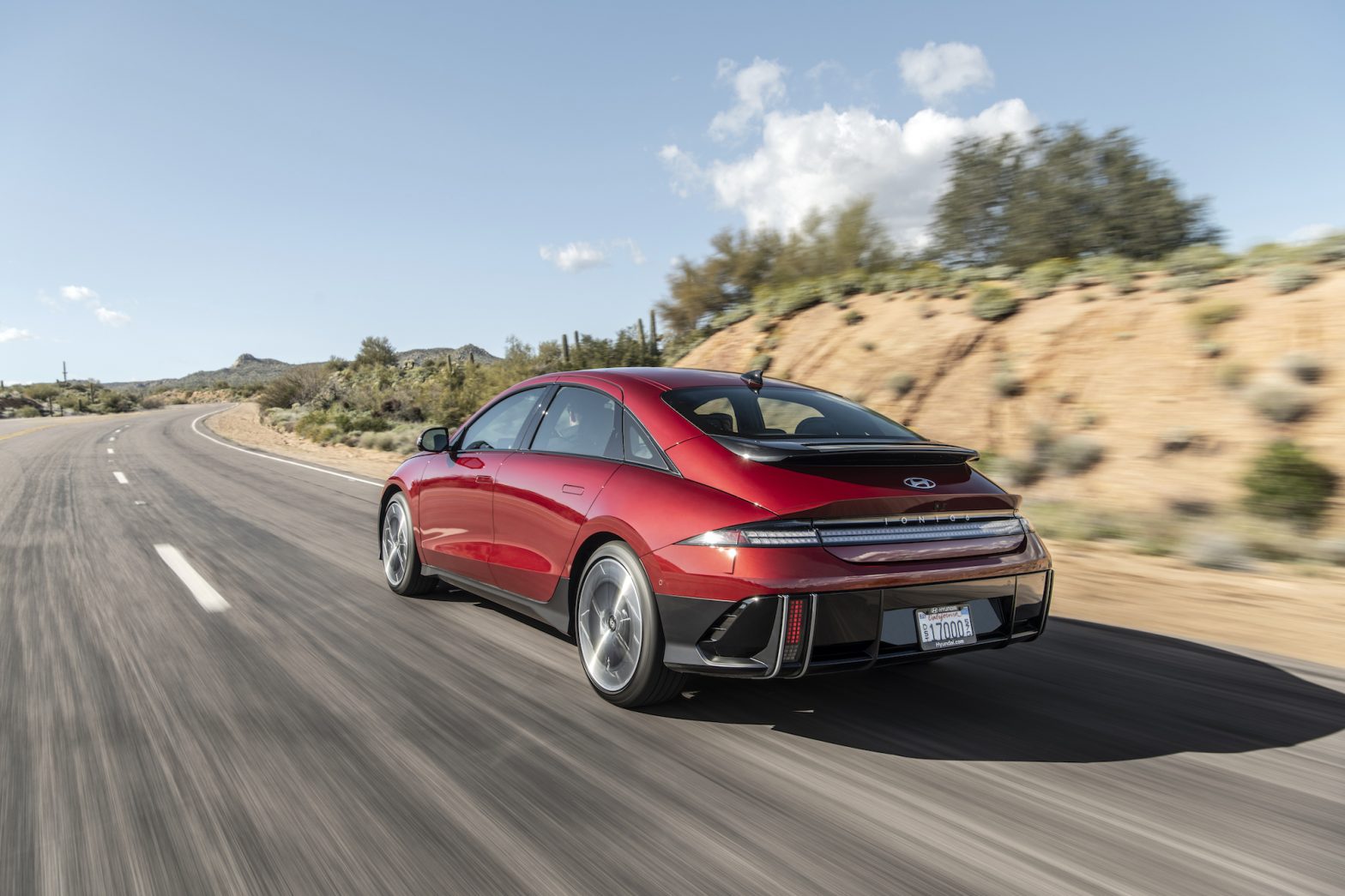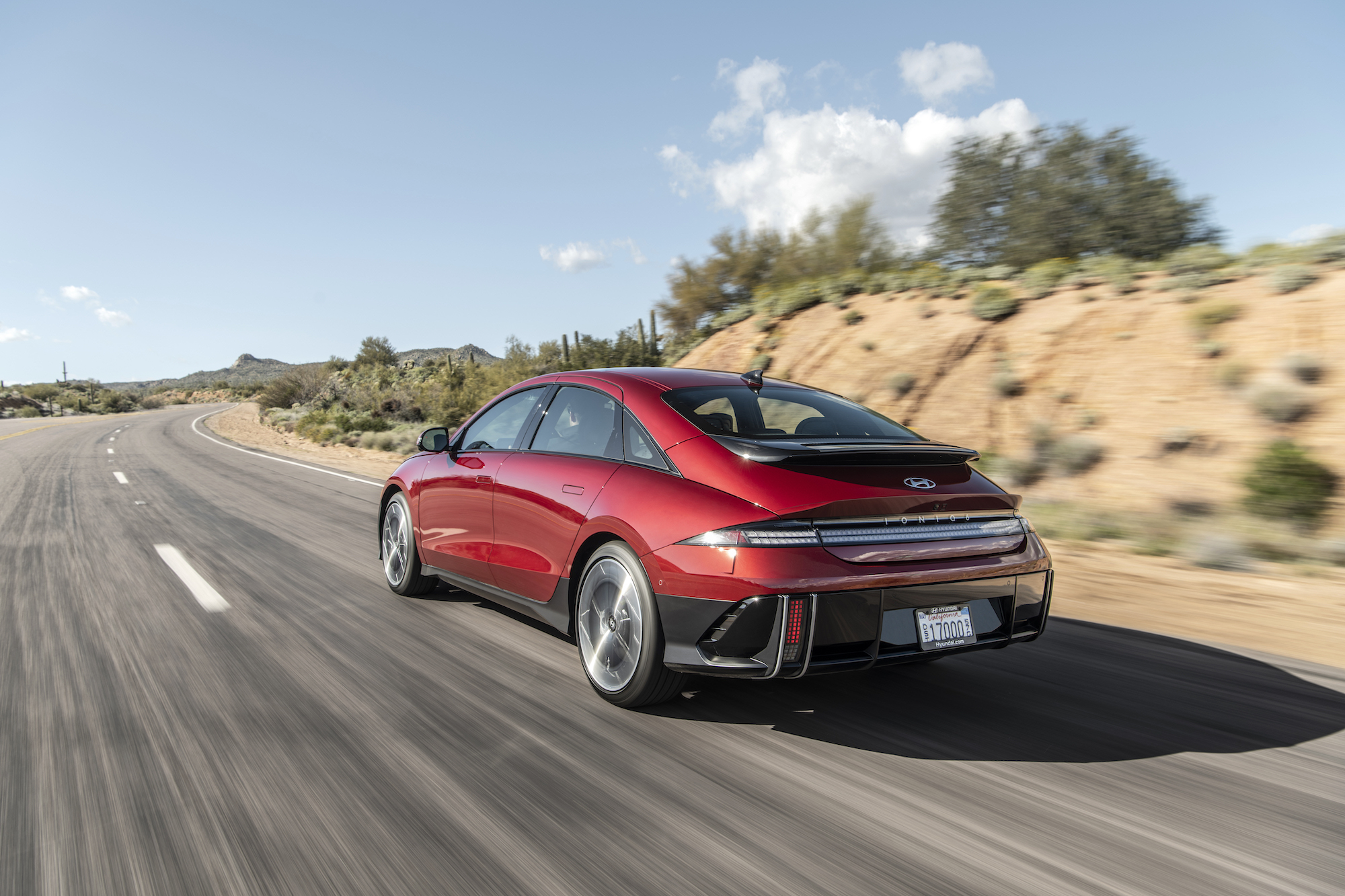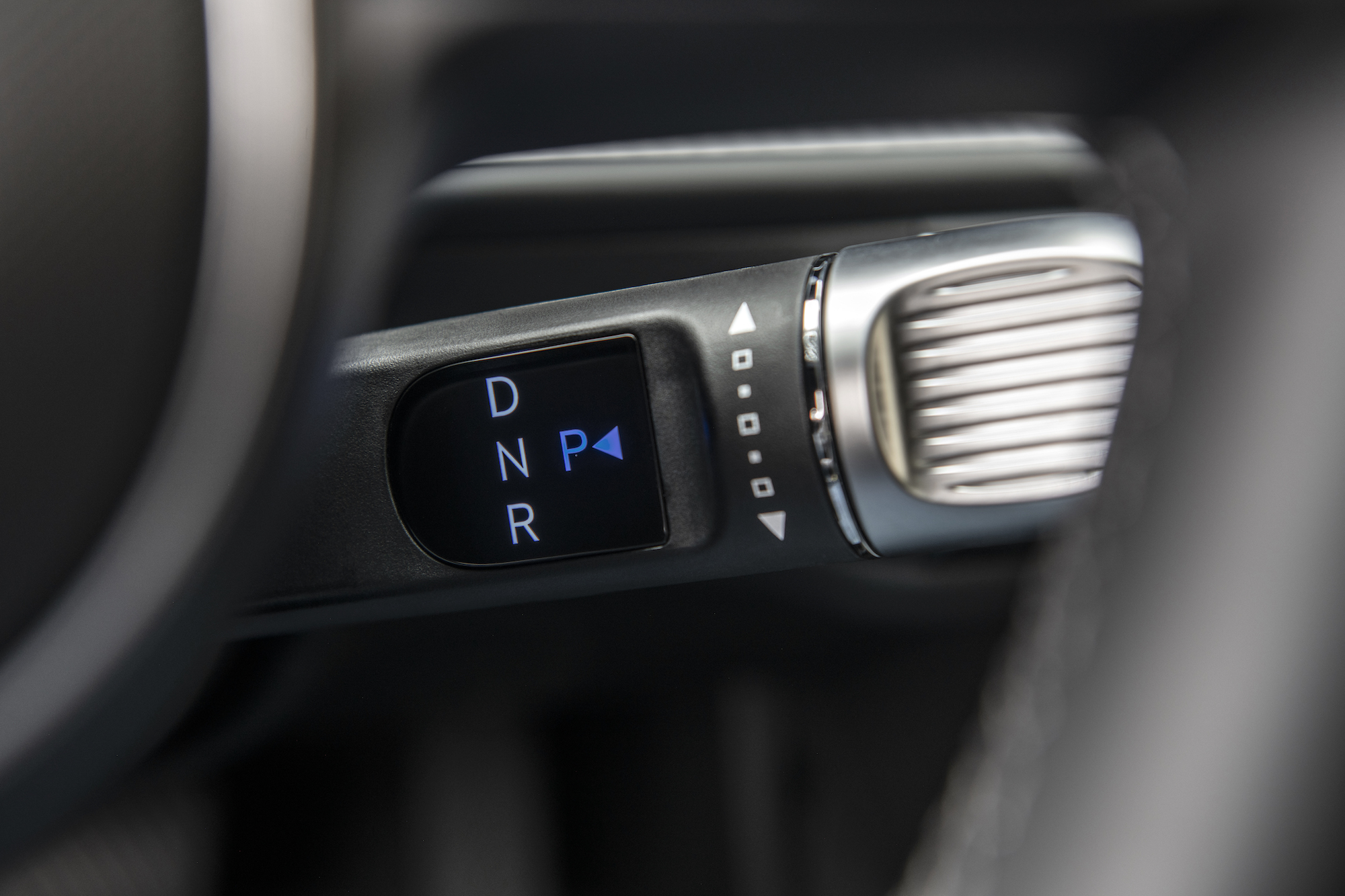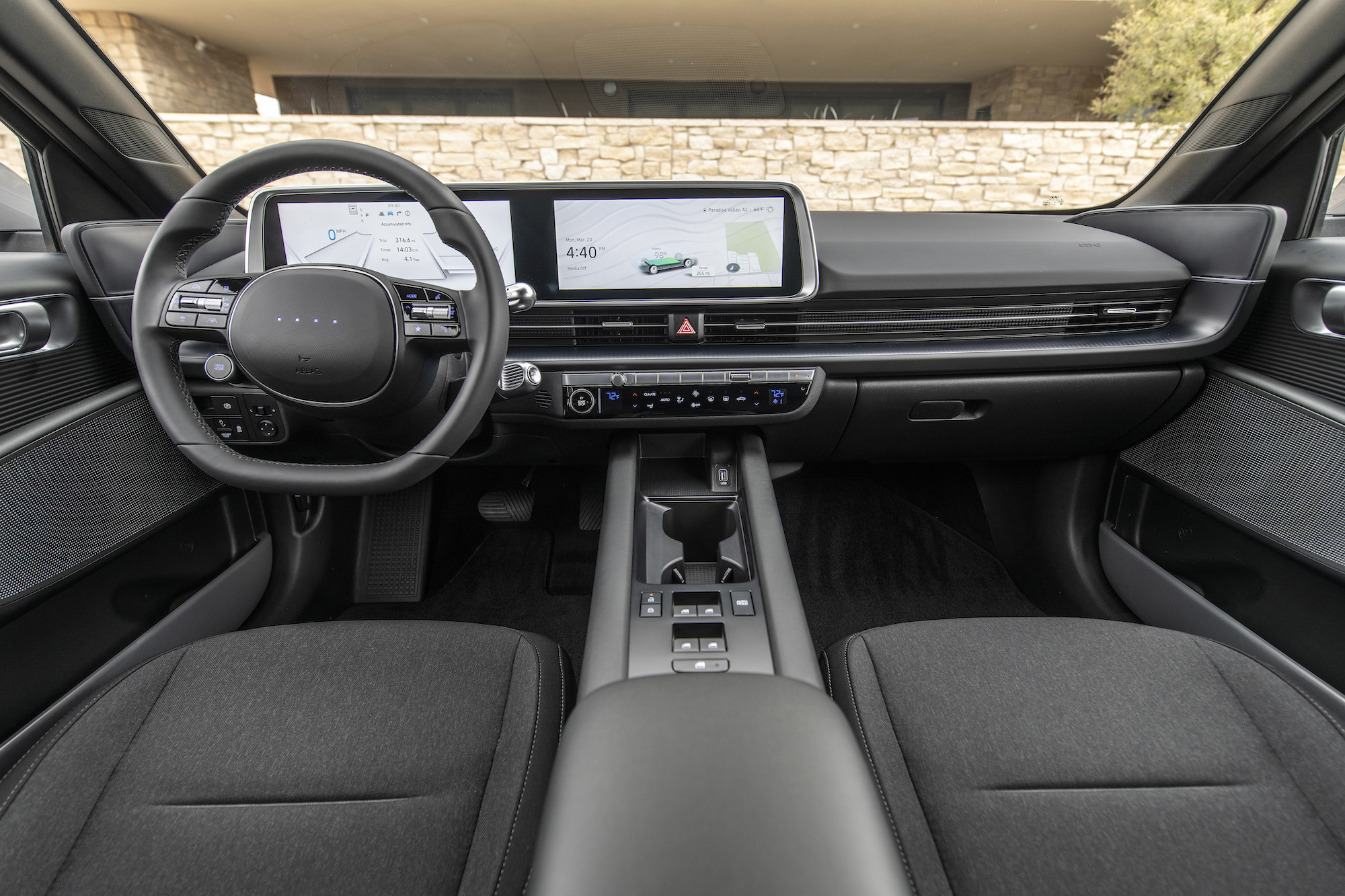In a world where nearly every automaker is pushing bigger, heavier, battery-electric SUVs and crossovers that all look the same, Hyundai is bucking the trend with its brand new, swoopy, tech-forward 2023 Hyundai Ioniq 6 sedan.
The stakes are high for the Hyundai Ioniq 6. Hyundai has cast the sedan as a worthy rival to the Tesla Model 3, an EV that has dominated the market. The Ioniq 6 is also a key product in the automaker’s plan to sell 1.87 million EVs annually by the end of the decade and gain a 7% market share in the global battery-electric vehicle market. (Hyundai plans to invest more than $10 billion toward accelerating electrification and autonomous vehicle technology in the U.S. by 2025 to help it reach that goal.)
The 2023 Ioniq 6, which will be available this spring, hits most marks. It’s quiet, quick and efficient and manages a roomy interior despite its sporty exterior. But will it attract buyers? Here’s our first impressions after a few hours driving the compact sedan in Orange County, California, near Hyundai’s North American headquarters, as part of the World Car Awards testing.
Nuts and bolts
Hyundai is offering customers a variety of options for the Ioniq 6 sedan, including 53 kWh and 77.4 kWh battery pack sizes and two motor layouts.
Regardless of the trim level, the Ioniq 6 sedan sits on the same E-GMP platform that underpins the Ioniq 5. All of the variants come with the same 800-volt architecture as the Ioniq 5, with a few small tweaks that make the sedan more efficient and gives it more than 50 additional miles of range over the award-winning crossover.
At the top of the heap — at least in terms of range — is the Ioniq SE long range rear-wheel drive version, which is outfitted with 18-inch wheels and a 77.4 kilowatt-hour battery pack that provides an estimated EPA range of 361 miles. The Ioniq 6 SE long range is priced at $45,500 (or $46,615 including delivery).
The most affordable version is the Ioniq 6 SE standard range, which has a base price of $41,600 ($42,715 including delivery), that is equipped with a 53 kWh pack and a rear electric motor that provides an EPA-estimated range of 240 miles.
The AWD long-range model has an EPA-estimated range of 316 miles and a base price of $49,000 ($50,115 including delivery). Several other trims that include the larger 20-inch wheels have ranges between 270 and 305 miles.
The base model of the Ioniq 6, in rear-wheel drive format, offers 225 horsepower and 258 lb-ft of torque, while the dual-motor, all-wheel drive version that I drove has 320 horsepower and 446 lb-ft of torque.
Tesla has three versions of the Model 3, only two of which are currently available. The Model 3 rear-wheel-drive sedan can travel 272 miles on a single charge and has a base price of $42,990. The Model 3 dual-motor performance version has an EPA-estimated range of 315 miles and a base price of $53,990. The long-range Model 3, which has 358 miles of range, is currently not available.
Customers who only care about an EV with the most range for the lowest price might find the cheaper Ioniq SE long-range rear-wheel drive version (361 miles for $45,500) more appealing than the higher-priced Model 3.
The Ioniq 6 also gets an EPA-estimated 140 MPGe combined, which happens to match the two Lucid Air models at the top of the EPA’s Top Ten list.
The impressive range is due in part to the Hyundai Ioniq 6’s very low drag coefficient of just 0.22. Hyundai said it was able to achieve that through a combination exterior and functional design features, including the swoopy roofline, ducktail spoiler, active air flaps, wheel gap reducers, boattail shape, full underbody cover, deflectors and reduced wheel-arch gaps.
In typical Hyundai manner, the Ioniq 6 comes standard with adaptive cruise control and lane-keeping assistance, as well as other safety features. The adaptive cruise control is comfortable in stop-and-go traffic, neither leaving too much of a gap nor accelerating too fast, only to slam on the brakes. It drives like a well-behaved, non-texting human being, which is a welcome feature in LA’s stop-and-go traffic.
On the road
On the road, the design of the Ioniq 6 stands out. It looks a little bit like a VW Beetle and a Hyundai Sonata got together and had a good-looking baby, with plenty of tech-forward features, including more than 700 Parametric Pixels in, on and around the vehicle.
The end result is a sedan that feels more sci-fi than the other “meh” options on the road today.
The loop I drove took us out on the crowded 405 highway in Southern California and up into the area around Tustin and Lake Forest, California. The drive took place mostly on fast-moving toll roads with sweeping turns. Because I was in a prototype, I had Hyundai handlers in the vehicle with us the entire day, which prevented us from deviating from the prescribed path. In spite of these constraints, the limited time I spent behind the wheel of the new Ioniq 6 did prove that it was a capable, comfortable, quiet and quick machine on the road.
The Ioniq 6 has four modes: eco, comfort, sport and snow. Because I was driving in Southern California and not heading to altitude, I didn’t get a chance to try out snow, but did experience eco, comfort and sport modes.
In eco mode, the compact car doesn’t lag or feel as if it’s being restricted. It is a bit less punchy in eco mode, especially when you first step on the accelerator. In comfort mode, the performance ticks up a notch, but it still isn’t the throw-you-back-in-your-seat experience that customers have come to expect in an EV. (The less-is-more approach makes sense since Hyundai expects that most people who purchase the little EV will have little to no experience with EV torque and acceleration.)
In sport mode, however, the Ioniq 6 is much more spirited, offering that true EV experience of sharp acceleration. Hyundai says that the vehicle can travel from 0 to 60 miles per hour in less than five seconds in the dual motor, all-wheel drive configuration.
One of the somewhat niggly things about the Ioniq 6, which owners will get used to quickly, is the location of the gear selector. Like the Ioniq 5, the 6’s selector is located on the steering wheel column and is a bit hidden behind the wheel itself. Once you locate it, you rotate the end of the knob on the stalk to put the car into drive and press the end of the stalk to put it into park.
Interior and in-vehicle tech
Inside the Ioniq 6, customers will discover a minimalist and spacious interior.
While the wheelbase of the Ioniq 6 is 116.1-inches, it’s shorter than the Ioniq 5 by two inches. Surprisingly that doesn’t translate to a cramped interior, thanks to Hyundai’s thoughtful layout and interior design inside the cabin. As an example, designers minimized the size of the door armrests to provide more hip width inside the vehicle. There’s plenty of room in the back seats for a six-foot person to ride comfortably for a good long while, too.
A pair of screens stretch from in front of the driver to the passenger under one piece of glass. The driver’s information screen and infotainment screen each are 12.3-inch displays, with the infotainment screen getting touch capabilities.
The vehicle during my test was a prototype, forcing me to use Android Auto for navigation. I didn’t get the chance to try out some of the features that Hyundai includes with the Ioniq 6, including Bluelink, phone as a key and the on-board navigation system. Bluelink is Hyundai’s app that allows owners to see details like battery usage, locate chargers and even manage charging time to help cut down on electricity costs.
The Hyundai Ioniq 6 also comes with a digital key 2.0 system that allows owners to use their iPhone, Apple Watch or a Samsung Galaxy smartphone to lock and unlock the vehicle and start it. The feature also allows for key sharing with family members. Once you put a linked iPhone or Samsung Galaxy on the wireless charger, or hold an iWatch near it, and push the start button, the Ioniq 6 will start up.
The voice recognition system, which allows users to control the temperature, radio station and other controls using simple language prompts, was intuitive if a little bit slow. This could be because I was driving a prototype. We’ll have to wait and see what the Ioniq 6 is like in a longer-term test once the vehicle lands on U.S. shores.
Battery tech and charging
Hyundai says that the Ioniq 6 can go from 10% to 80% charged in just 18 minutes on a 350 kW charger (DC Fast). However, I didn’t have the opportunity to try out the vehicle’s fast-charging capabilities during this first impressions drive (I will once I have the vehicle longer than a day).
The company also included a charging feature that allows the Ioniq 6 to accept 400-volt charging without an adapter by using an inverter and a motor to boost 400 volts to 800 volts.
The sedan also includes battery conditioning so that when a charging destination is put into the onboard navigation system, the vehicle will automatically pre-condition the battery to prepare it to take maximum charge.
Like the Ioniq 5 before it, Hyundai has also included V2L (vehicle-to-load) functions in the sedan. That means that customers can charge electric bicycles, scooters, camping equipment or even charge a stranded EV (1.9 kW peak power using a standard 120-volt outlet) by plugging into the Ioniq 6’s accessory adapter and outside charger located near the charging port.
Hyundai has managed to find a balance between standout design, technology, range, performance and price. Hyundai may have produced a vehicle that will make the transition from gasoline to EV much more comfortable for the average buyer.



